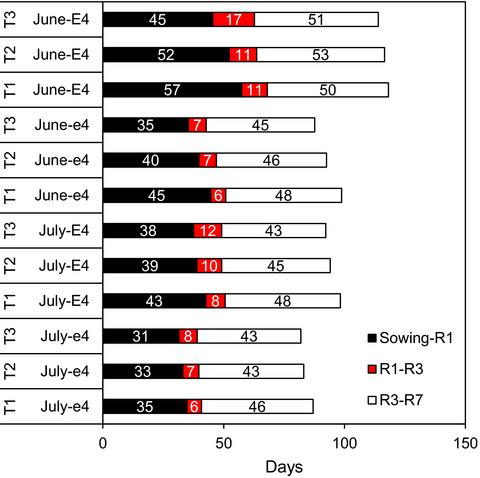当前位置:
X-MOL 学术
›
Food Energy Secur.
›
论文详情
Our official English website, www.x-mol.net, welcomes your
feedback! (Note: you will need to create a separate account there.)
Is the yield change due to warming affected by photoperiod sensitivity? Effects of the soybean E4 locus
Food and Energy Security ( IF 4.0 ) Pub Date : 2019-10-23 , DOI: 10.1002/fes3.186 Etsushi Kumagai 1 , Tetsuya Yamada 2 , Toshihiro Hasegawa 1
Food and Energy Security ( IF 4.0 ) Pub Date : 2019-10-23 , DOI: 10.1002/fes3.186 Etsushi Kumagai 1 , Tetsuya Yamada 2 , Toshihiro Hasegawa 1
Affiliation

|
Modeling studies predict that global warming will shorten growth duration and reduce seed yield of early‐maturing soybean (Glycine max) cultivars, but that late‐maturing cultivars could mitigate this reduction. This is widely discussed but has not been validated experimentally. Time of soybean maturation is determined by several photoperiod‐sensitive loci. Here, we focused on the E4 locus, and tested the hypothesis that this locus would mitigate the growth period shortening and yield reduction due to warming. We sowed cv. Enrei with the dominant E4 allele and a near‐isogenic line with recessive e4 allele (NIL‐e4) on two dates (normal vs. late, with a shorter photoperiod) and grown under three temperature regimes (near‐ambient, and 2.0 and 4.6°C above ambient) in sunlit greenhouses in a cool region of Japan. The period from sowing to flowering (R1) decreased with increasing temperature, regardless of genotype and sowing date. However, increased temperature prolonged the period from R1 to the beginning of pod filling (R3) in Enrei but not in NIL‐e4 for either sowing date. This indicates that increasing temperature shortened the period before R1, exposing Enrei with E4 to a longer photoperiod and therefore slowing its development. For both sowing dates, pod number and seed yield increased with warming in Enrei. Since the days from R1 to R3 and the cumulative radiation for this period were positively correlated with pod number in Enrei, the greater yield response was explained mostly by the prolongation of this period caused by warming. However, the yield increase resulted partially from the current mean growing season temperature, which was near or below the optimum for yield. We conclude that the E4 locus can increase seed yield under future warming in cool regions of Japan. This result demonstrates the potential importance of modifying photoperiod sensitivity to increase soybean yield under future warming.
中文翻译:

受气候变化影响的产量变化是否受光周期敏感性影响?大豆E4基因座的作用
模型研究预测,全球变暖将缩短早熟大豆(Glycine max)品种的生长时间并降低其种子产量,但晚熟品种可以减轻这种减少。对此进行了广泛讨论,但尚未通过实验验证。大豆成熟的时间取决于几个对光周期敏感的基因座。在这里,我们重点研究了E4基因座,并验证了该基因座将减轻生长期缩短和因增温而导致产量降低的假设。我们播种了简历。具有优势E4等位基因的Enrei和具有隐性e4等位基因的近等基因系(NIL‐ e4)在日本凉爽地区的日光温室中的两个日期(正常与较晚,光周期较短)上并在三种温度条件下(接近环境温度,比环境温度高2.0和4.6°C)生长。随基因温度和播种日期的增加,从播种到开花(R1)的时间随温度的升高而缩短。但是,温度升高会延长恩里地区从R1到豆荚灌浆开始(R3)的时间,但在任一播种期均不延长NIL- e4的时间。这表明温度升高缩短了R1之前的时间,使Enrei与E4接触到更长的光周期,因此减慢了它的发展。对于两个播期,Enrei的豆荚数量和种子产量均随着变暖而增加。由于从R1到R3的天数以及这段时间的累积辐射与Enrei的豆荚数成正相关,因此更大的产量响应主要是由变暖导致的这段时间的延长。但是,单产的提高部分是由于目前的平均生长季节温度,该温度接近或低于最佳单产。我们得出的结论是,在未来的变暖情况下,E4基因座可以在日本凉爽的地区提高种子产量。该结果表明,在未来变暖的情况下,改变光周期敏感性以增加大豆产量的潜在重要性。
更新日期:2019-10-23
中文翻译:

受气候变化影响的产量变化是否受光周期敏感性影响?大豆E4基因座的作用
模型研究预测,全球变暖将缩短早熟大豆(Glycine max)品种的生长时间并降低其种子产量,但晚熟品种可以减轻这种减少。对此进行了广泛讨论,但尚未通过实验验证。大豆成熟的时间取决于几个对光周期敏感的基因座。在这里,我们重点研究了E4基因座,并验证了该基因座将减轻生长期缩短和因增温而导致产量降低的假设。我们播种了简历。具有优势E4等位基因的Enrei和具有隐性e4等位基因的近等基因系(NIL‐ e4)在日本凉爽地区的日光温室中的两个日期(正常与较晚,光周期较短)上并在三种温度条件下(接近环境温度,比环境温度高2.0和4.6°C)生长。随基因温度和播种日期的增加,从播种到开花(R1)的时间随温度的升高而缩短。但是,温度升高会延长恩里地区从R1到豆荚灌浆开始(R3)的时间,但在任一播种期均不延长NIL- e4的时间。这表明温度升高缩短了R1之前的时间,使Enrei与E4接触到更长的光周期,因此减慢了它的发展。对于两个播期,Enrei的豆荚数量和种子产量均随着变暖而增加。由于从R1到R3的天数以及这段时间的累积辐射与Enrei的豆荚数成正相关,因此更大的产量响应主要是由变暖导致的这段时间的延长。但是,单产的提高部分是由于目前的平均生长季节温度,该温度接近或低于最佳单产。我们得出的结论是,在未来的变暖情况下,E4基因座可以在日本凉爽的地区提高种子产量。该结果表明,在未来变暖的情况下,改变光周期敏感性以增加大豆产量的潜在重要性。









































 京公网安备 11010802027423号
京公网安备 11010802027423号